Alan Cain, Wildlife Biologist
Mike Wallace, Interpretive Specialist
Texas Parks & Wildlife – WILDLIFE REGION IV

A Guide to Age Determination
of White-tailed Deer
Tooth wear and replacement is one of several methods for aging white-tailed deer. Texas Parks and Wildlife biologists have been using this deer aging technique to manage deer on ranches, wildlife management areas and by county since 1965. Although this method is not perfect, it has been used for the past 35 years in the successful management of deer herds in Texas. Deer are aged by examining the wear and replacement of the premolars and molars of the lower jaw. As a deer grows older, its teeth continue to wear. As the enamel begins to wear away, and exposes the dark dentine material, noticeable distinctions in tooth wear occur between each age class. Deer are aged in year and half increments, such as 1 1/2, 2 1/2, 3 1/2, etc., since fawns are born from late May through July and are not harvested until the fall hunting season.
Biologists, landowners or land managers may be interested in deer ages from a deer management standpoint. Age data provides information about deer herd characteristics, hunting or mortality pressure on a particular age class, and progress of the wildlife management program. Age data becomes a valuable piece of information when used with other data such as antler characteristics, dressed body weights or lactation in females. Deer herd trends can thus be monitored if enough data are collected over time. Often these trends can be related to a particular management style, climatic conditions or any other factors affecting deer. Dressed body weights, age and antler measurement data should be collected every year and from every deer harvested. Collecting partial data, only occasionally during a season, or every couple of years may result in land managers making uninformed decisions about deer management.
Aging deer using the wear and replacement method is not difficult, but it does require practice. When aging a deer, it is helpful to cut the skin along the edge of the jaw to allow better inspection of the teeth. Do not cut the skin if planning to mount the deer. Taxidermists will cape out the deer head and save the lower jaw if asked. A jaw spreader and small flashlight may also be used to prop open the jaw while examining the teeth, especially when the skin is not to be cut. Be sure to remove any food particles or debris to maintain a clear view of the teeth along the jaw. Inspect teeth on both sides of the jaw to confirm that wear is consistent. (See photo on back cover).
Deer Teeth Parts
Cusp: a point or projection on a tooth
Back Cusp: very last cusp on tooth 6 on cheek-side of the jaw
Lingual Crest: tooth ridge adjacent to the tongue
Enamel: hard, white, outer coating of a tooth
Dentine: soft inner core of a tooth, dark brown color Infundibulum: crescent-shaped depression in the central crown of a tooth between the enamel ridge or crest
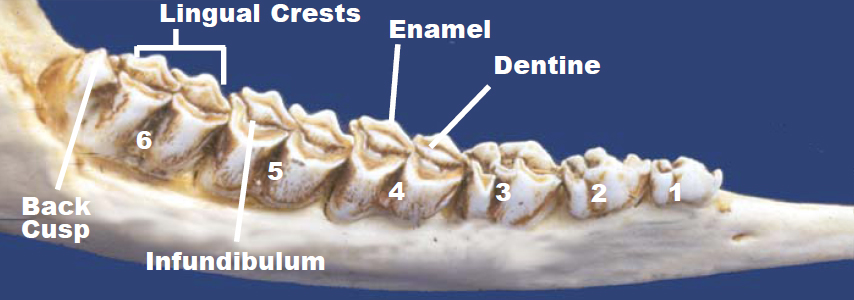
Fawn (1/2 year)
Aging fawns should not be difficult. For more clarification, inspection of the lower jaw will indicate age. Fawns have 5 or less teeth present and the third premolar (tooth 3) has 3 cusps. Tooth 6 has not yet erupted. In younger fawns tooth 5 has not erupted and only 4 teeth will be visible.
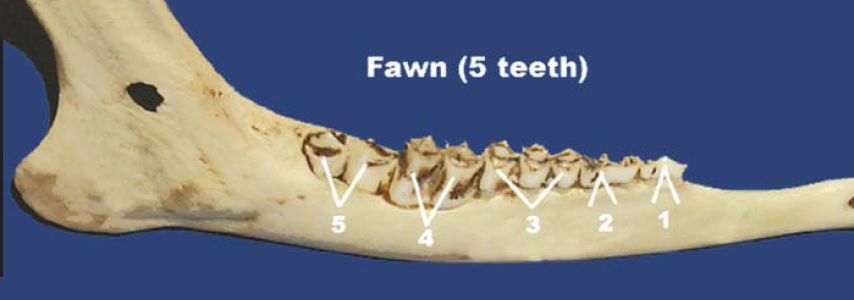
fawn jawbone
1 1/2 years
Tooth 3 (3rd premolar) has 3 cusps. Tooth 6 has erupted and is slightly visible just above the gum line.
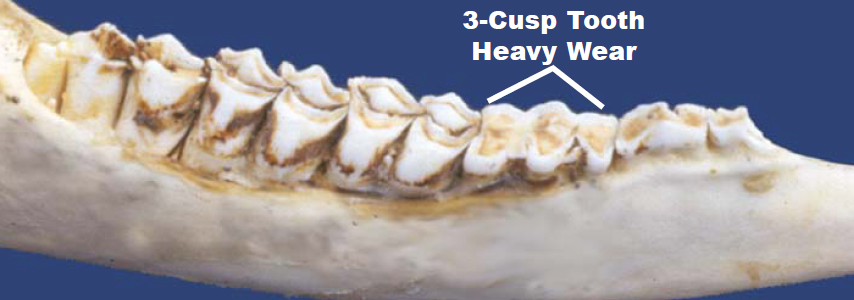
1 and 1/2 year jawbone
2 1/2 years
Lingual crest on all molars are sharp and pointed. Tooth 3 now has 2 cusps. Back cusp of tooth 6 is sharp and pointed. Enamel is wider than the dentine in tooth 4, 5 and 6.
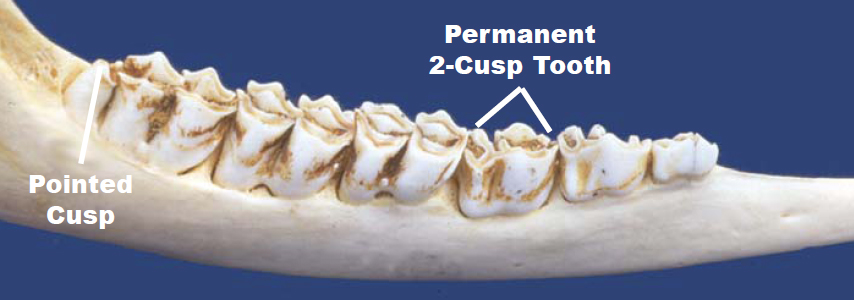
2 and 1/2 year jawbone
3 1/2 years
Lingual crest on tooth 4 is blunt. The dentine is as wide or wider than the enamel in tooth 4. The back cusp on tooth 6 is forming a concavity.
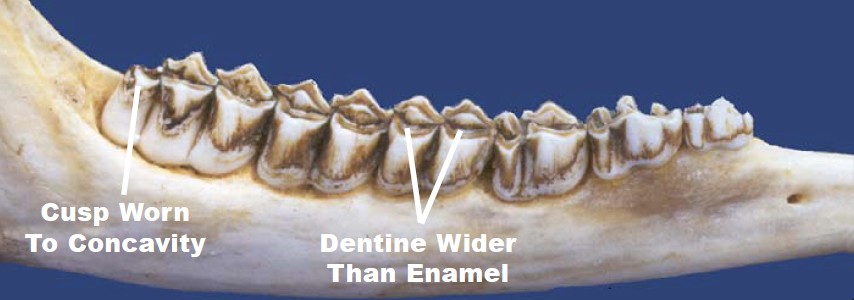
3 and 1/2 year jawbone
4 1/2 years
Lingual crest on tooth 4 are almost rounded off and lingual crest in tooth 5 are blunt. The dentine in tooth 4 is twice as wide as the enamel. The dentine in tooth 5 is wider than the enamel. The back cusp on tooth 6 is worn so badly that it slopes downward towards the cheek.
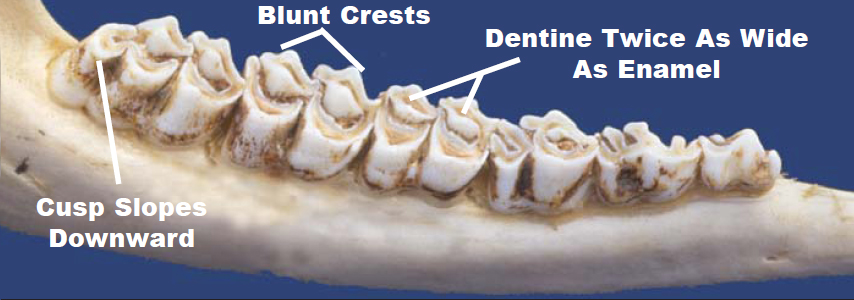
4 and 1/2 year jawbone
5 1/2 years
Lingual crest is worn away on tooth 4 and rounded in tooth 5.
Lingual crest in tooth 6 is blunt. Dentine in tooth 6 is now wider
than the enamel.
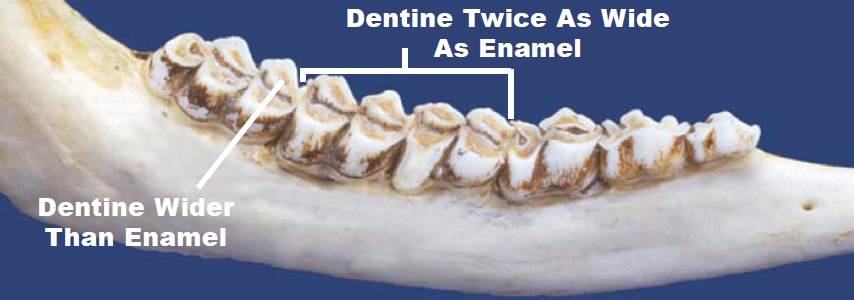
5 and 1/2 year jawbone
6 1/2 years
Tooth 4 is worn completely smooth; no enamel ridge should be
visible in the center of tooth 4. Small enamel ridge will be
present in center of tooth 5 and tooth 6. Lingual crest on tooth
5 is almost worn away and rounded in tooth 6.
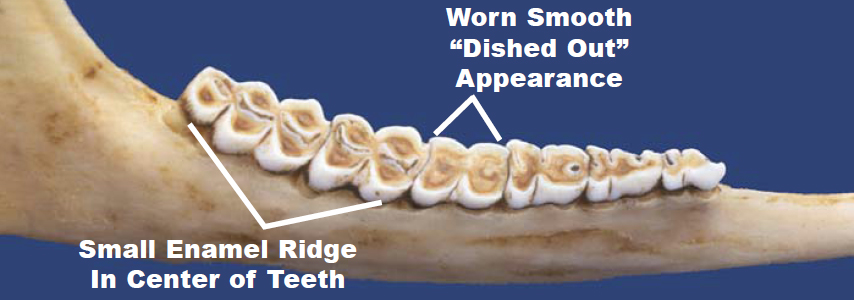
6 and 1/2 year jawbone
7 1/2 years
Tooth 4 and tooth 5 are worn smooth; no enamel ridges are
present in the center of these teeth. Lingual crest is gone from
tooth 6. Infundibulum in tooth 6 is a narrow crescent shape.
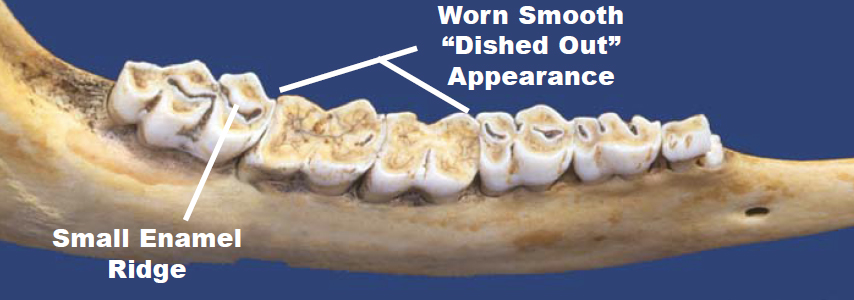
7 and 1/2 year jawbone
8 1/2 years
Tooth 4, 5 and 6 are completely dished out and no enamel
ridges are showing in the center of these teeth.
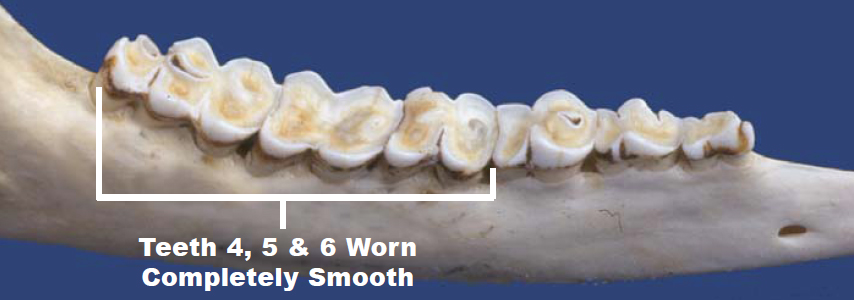
8 and 1/2 year jawbone
Using a Jaw Spreader
A simple jaw spreader can be made from 1/4 inch rebar and welded into a similar shape as shown in the photo.
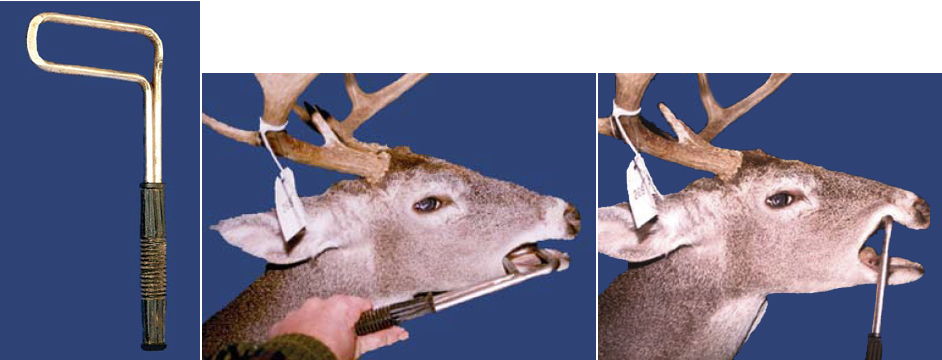
Insert jaw spreader into mouth as shown. Be sure spreader is pushed completely through the mouth. Rotate jaw spreader downward as shown in the photo.
Teeth are now visible for inspection. A small light may be helpful for viewing teeth.
 Texas Parks and Wildlife
Texas Parks and Wildlife
PWD BK W7000-755 (07/03)
4200 Smith School Road, Austin, TX 78744
www.tpwd.state.tx.us
